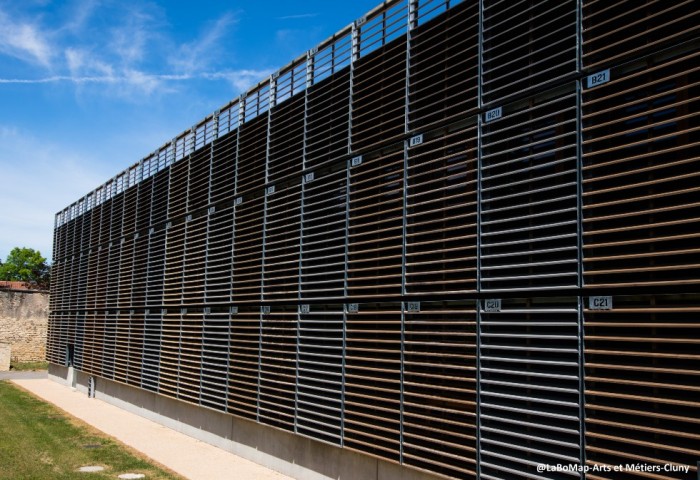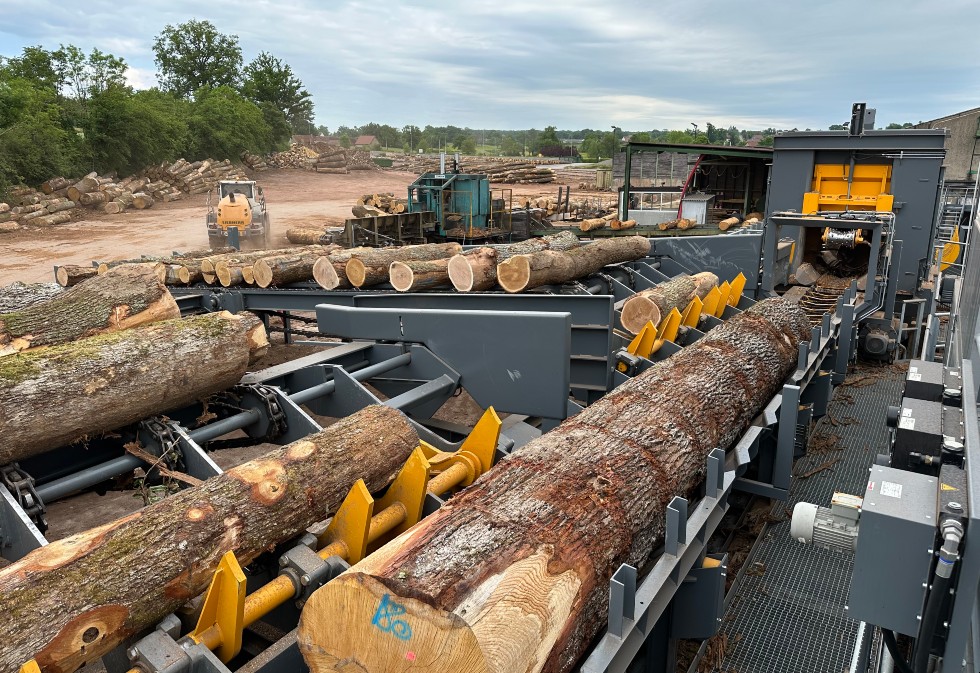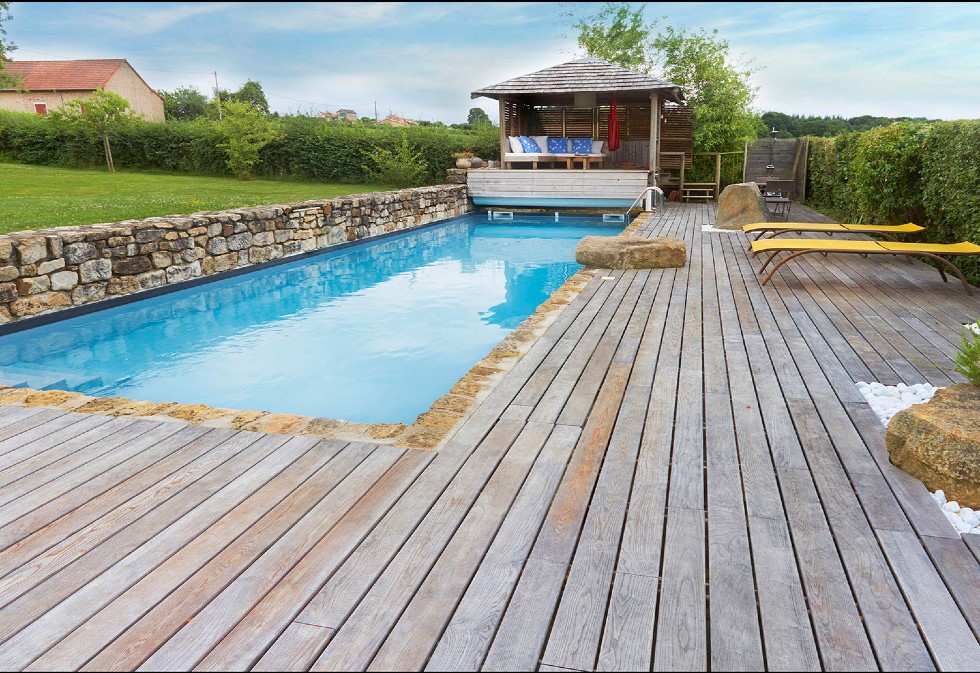Robert Collet, Arts et Métiers campus at Cluny: “an experimental wall to observe the ageing process of natural and treated woods, in real time”

Since November 2017, the external west-facing wall of the wooden hall on the campus of Arts et Métiers Paris Tech at Cluny has had an original appearance. Over a surface area of more than 300 m², it is covered with 69 removable cladding panels. A combination of timber strips of various species, with different treatments and different finishes. Objective: to observe the ageing of the material. This project was made possible thanks to sponsorship from the Ducerf group, who invested in it. Interview with Robert Collet, the head of the wood team at LaBoMap on campus at Cluny…
What was the genesis of this experimental wall project?
Robert Collet: In fact, it’s really the culmination of a global project. In order to cope with the increase in timber activities at Arts et Métiers, we had an extension of 1,000 m² built. It made sense to build a wooden hall, in line with our activities for the promotion of local timber. We are particularly interested in secondary quality hardwoods, as well as fast growing timber like the douglas fir, that are important in economical terms and that can offer technical solutions. This wall was the last link in the process and a nod at what we do here.
Why did you approach Ducerf for sponsorship?
Robert Collet: We wanted to find ways of obtaining wood under suitable conditions. And it just so happens that at Arts et Métiers we have a foundation that enables us to benefit from sponsorships. So it was a natural decision to turn to the Ducerf group and its subsidiaries. They were, given their resources and their products, capable of providing us with treated wood in the small quantities required. So they accepted with enthusiasm, and provided us with technical support in the person of Thibault Chastagnier. It was the company I-Tech Bois that oversaw the execution of works. It involves 69 removable cladding panels over 302 m² of façade. Each one is made up of a different wood species with different treatments in order to observe the ageing process of the materials in real time.
Oak, poplar, ash, douglas fir, larch and maritime pine...
Which species are used?
Robert Collet: First of all obviously is oak, which is well known for its quality, its natural durability and for its heartwood, superior even to douglas for example. Among the hardwoods, we also have poplar which is not at all resilient, but which has good impregnability and reacts extremely well to heat treatment. So conditions for its reuse are very good. We also have ash, which can be found all over France. It reacts better to heat treatment than oak, but is not as naturally resilient. And then we have softwood species like douglas. Its pink-orange appearance means that it’s often used for cladding. Next, we have larch. Despite the fact that there’s not a lot of it in our region, it’s considered to be a reference, as it’s known for being a naturally durable softwood. For cladding qualities, we talk about class 3, these are woods that naturally possess this class. We should also mention another wood: maritime pine. This is widely used and recognised. In Burgundy, it’s a little far away from us, but it’s a national wood. It has good impregnability and is therefore easily treated.
What do you expect to see with this experimental wall?
Robert Collet: The wall is west-facing, so it’s exposed to the elements: the sun contributes to the oxidizing of wood and rain also has an effect on its ageing. We are therefore going to be able to analyse the greying, the natural aspect of certain strips and, in particular, the different stages of discolouration. We’re also going to be able to see which finishing products give the wood a colour that is almost identical to that which it would obtain over time. And finally, on this façade, we can also test performance in terms of durability: deterioration, appearance of fungus, etc.
Good performance of heat treated woods
The wall went up last November, what are your initial observations?
Robert Collet: From an aesthetic point of view, we can see that rain directly affects the hue and we can also see woods that have become discoloured due to exposure. The woods that were pre-greyed and to which we applied a finishing product remain homogeneous. Otherwise, we’re clearly able to observe the performance of the wood and the fact that some woods have a more engaging appearance and are better appreciated by the public. Furthermore, in terms of dimensional stability and mechanical performance, in all these woods, chosen either for their natural resilience, or for having undergone heat treatment, we observe reactions that indeed correspond to what we expected.
Can the general public also come and see it for themselves?
Robert Collet: Not many people come to see us, but the neighbouring abbey, which receives more than 100,000 visitors every year, has a path transformed into an arboretum that leads directly to the experimental wall. The idea is to install signs with, for example, a QR code pointing to the website where information on all the species and types of finish and treatment can be found, panel by panel. The objective is to build visitor awareness.
“A project that should have a long lifespan as these are long-lasting woods”
And of course, this project is going to play a genuine educational role with your students...
Robert Collet: Through our theoretical and practical lessons, we explain to them that wood is a great material, but that you need to know how to exploit it. Here, we have actual on-site examples to show them that woods can behave differently over time, and enabling us to measure their mechanical and physical properties. Generally speaking, students have a favourable view of the material. And experiments like this enable us to steer them towards an understanding of dimensioning and construction, using very large volumes of wood.
How long will the experiment go on for?
Robert Collet: This structure is set to be here for a long time as these are durable woods, in terms of their integrity. In a few years’ time, all the panels will become increasingly uniform and it will be difficult to notice the differences. But the idea, for the time being, is to do nothing. If there are problems with mechanical performance, we will replace the strips. The panels are in any event removable as they are simply hooked on to bolts. Everything is easily interchangeable if we want to test other species. So this is an exciting long-term project!







